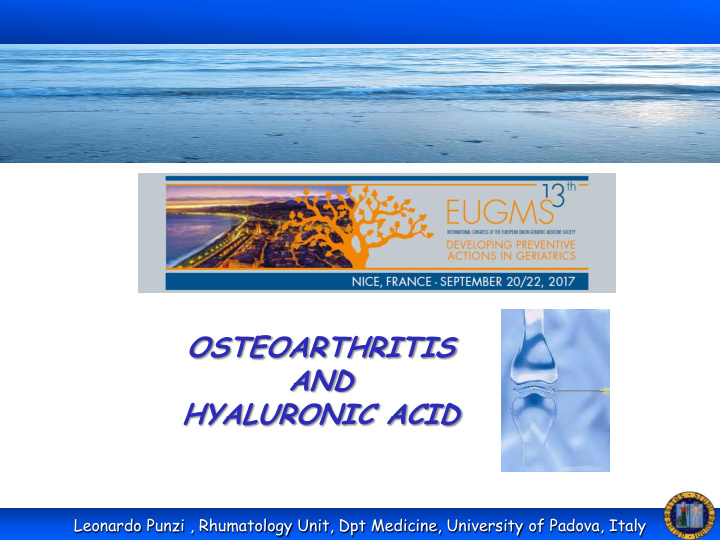



OSTEOARTHRITIS AND HYALURONIC ACID Leonardo Punzi , Rhumatology Unit, Dpt Medicine, University of Padova, Italy
DISCLOSURES Abbvie Fidia SpA Grunenthal Menarini Pfizer MSD
EPIDEMIOLOGY OF OSTEOARTHRITIS • The most common form of chronic arthritis/joint disease • Strongly related with age radiological evidence in: 85% of aged at least 75 yrs, 50% of those over 65 yrs r adiographic OA of the knee joint: 70 % of the population over 60 yrs of age • 15% of the population affected by symptomatic disease • Most common reason for total hip and knee replacement • Leading cause of chronic mobility disability • Attributed annual costs (medical care and lost wages) ~ 65 millions in US Leonardo Punzi , Rhumatology Unit, University of Padova, Italy
Allen & Golyghty, Curr Opin Rheumatol, 2015
WARNINGS AND PRECAUTIONS
Al Ahabadi et al, SJGM 2016
Guidelines for Elderly Patients with Osteoarthritis Oral NSAIDs Tramadol, Opioids, Duloxetin BC guidelines, 2009
KNEE OSTEOARTHRITIS IS A LOCAL DISEASE …Needing (First) Local Treatments • Topical NSAIDs • Intra-articular corticosteroids • Intra-articular hyaluronic acid
INTRA-ARTICULAR HYALURONIC ACID • Hyaluronic acid (HA) is a natural biological substance, a high-molecular weight glycosaminoglycan • It is a major component of ligament, tendon, and cartilage structure and of synovial fluid, responsible for the visco-elastic properties of the latter. • Since depolymerization of HA in the synovial fluid of OA was considered one of the main causes of the mechanical pain, Balazs in 1960 first proposed to use the intra-articular (IA) HA administration with the aim to restore the rheological properties of synovial fluid, called visco-supplementation • However many other mechanisms have been proposed, including an anti-inflammatory effect • Preclinical and clinical evidence support the hypothesis that this treatment modality can be useful, and indeed, IA injections of HA have been shown to reduce pain and improve joint function in OA in many studies Peyron & Balazs, Pathol Biol, 1976 Punzi L et al, Clin Exp Rheumatol; 7:247-50, 1989 Kotevoglu N,et al. Rheumatol Int 2006;26:325 – 30 Petrella RJ, et al. Arch Intern Med 2002;162: 292 – 8 Tamir E, et al. Clin Exp Rheumatol 2001;19:265 – 70
FDA APPROVED INTRA-ARTICULAR HYALURONIC ACID
INTRA-ARTICULAR HYALURONIC ACID IN THE INTERNATIONAL RECOMMENDATIONS Leonardo Punzi Cattedra ed Unità di Reumatologia, Azienda Ospedaliera Università di Padova
OARSI recommended the usage of HA for knee and Hip OA Part I: 2007 Part II: 2008 Part III: 2009 2014: uncertain recommendation for knee-only OA
Effect size (ES): 0.2=small, 0.5=moderate, > 0.8=large
Intra-articular Hyaluronic acid in second line
COMMENTARY ON INTRA-ARTICULAR HYALURONIC ACID • Longer-lasting pain control has been reported with IA HA compared with IA corticosteroids, possibly delaying the need for total joint replacement • No significant differences have been reported in symptom efficacy between IA HA and oral NSAIDs, suggesting that IA HA might be a good alternative to oral NSAIDs in older patients with knee OA or in those at a higher risk for NSAID-induced side effects • A combination of IA HA and a corticosteroid often administered in the clinical setting, based on the different mechanisms of action and trajectories of the two compounds:the rapid effect of corticosteroids and the long-term effect of HA • However, no clinical data are yet available from RCTs supporting such combined treatment • The safety profile of IA HA has recently been questioned by a meta-analysis that reported a risk of side effects (serious adverse events and local adverse events) in addition to therapeutic effects that barely reached significance when the analysis was limited to a selected fraction of trials • It is appropriate to point out that the considered studies were of poor methodological and reporting quality, rendering questionable the final conclusion that IA HA is not safe • Furthermore,this analysisis also in complete disagreement with the clinical setting,where only sporadic flares and no severe systemic side effects have been reported after IA HA treatment. Bannuru RR, et al. Osteoarthritis Cartilage 2011;19:611 – 9 Rutjes AW, et al. Ann Intern Med 2012;157:180 – 91 Bannuru RR, et al. Arthritis Rheum 2009;61:1704 – 11 Waddell DD,Bricker DC.J Manag Care Pharm 2007;13:113 – 21 Bannuru RR,et al. Semin Arthritis Rheum 2014;43:593 – 9
There are some problems … • The lack of comprehensive comparative effectiveness studies that look at all modalities is making informed treatment decisions difficult • Previous meta-analyses mostly looked at the efficacy of treatments vs. placebo only – Oral NSAIDs vs. oral Placebo: 0.44 (0.34 to 0.55) – IAHA vs. IA Placebo: 0.34 (0.22 to 0.46) • In most treatment guidelines for knee OA, NSAIDs are recommended ahead of IA HA • Not all IA HA are the same, in term of efficacy and safety
Forest plot of absolute treatment effects Acetaminophen 19.55 (16.48, 22.85) IA Placebo 21.97 (16.48, 27.46) Celecoxib 22.85 (21.09, 24.83) Naproxen 23.95 (21.53, 26.36) Ibuprofen 25.27 (21.09, 29.44) Diclofenac 27.02 (23.07, 30.76) IA Corticosteroids 29.00 (22.63, 35.15) IA Hyaluronic acid 29.44 (24.17, 34.93) 0,00 5,00 10,00 15,00 20,00 25,00 30,00 35,00 40,00 Absolute Change from Baseline [ Scale, WOMAC (0-100)] Red line at 20.00 represents the line of clinical significance.
Effect size (ES): 0.2=small, 0.5=moderate, > 0.8=large
Recommend
More recommend